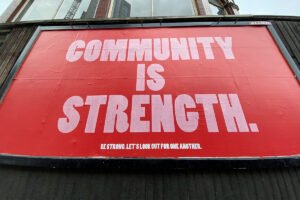
This August, Ohio voters returned a decisive “No” vote on a ballot question that would have drastically raised the requirements to change the state constitution.
The vote on the question, State Issue 1, was hailed as a win for progressives, as the ballot measure was widely seen as an attempt by state Republicans to enable the obstruction of an upcoming ballot initiative to enshrine abortion rights in the state constitution.
Ohioans were protecting a right not enjoyed by all Americans.
But the rejection of Issue 1 could also be seen as an affirmation by Ohioans of the potential of ordinary citizens of any political stripe to force their issues onto the ballot and to act as a check on the autocracy of state legislatures.
It is a stunning example of a rapid grassroots mobilization effort around what might easily have been written off as an obscure, non-intuitive off-year election issue—and, perhaps, an indication of potential electoral energy on the left, if progressive organizers can successfully tap it.
Ohio was just one example. The 2022 Kansas ballot referendum on abortion, in which voters overwhelmingly rejected an attempt to radically curtail abortion rights, was another. Five others—in Kentucky, Michigan, Vermont, Montana, and California—were recently returned in favor of abortion rights. And organizers are now looking toward future ballot measures as one of the only ways progressive voters might be able to overcome conservative or deadlocked state legislatures.
In defending their existing ballot initiative process, Ohioans were protecting a right not enjoyed by all Americans. Only about half of the states allow statewide ballot initiatives or referenda.
“It’s very clear that the Ohio State Legislature is not particularly representative of the state.”
“It’s a stopgap measure that can come from voters. It’s one of the only ways that we can really, truly check the legislature on some things,” says Rachael Belz, CEO of Ohio Citizen Action, a nonprofit advocacy organization that helped lead the door-knocking campaign to defeat Issue 1. “Even though it’s a big heavy lift and it’s expensive and time consuming, the fact that it’s there, that it’s even a possibility, is so critically important.”
In Ohio, the ability to mount ballot initiatives represents one way citizens can attempt to balance power and achieve real representation where, due largely to extreme gerrymandering, the state legislature doesn’t necessarily resemble its population.
“It’s very clear that the Ohio State Legislature is not particularly representative of the state as a whole,” historian Joshua Zeitz noted in discussing the Ohio vote on WNYC’s The Brian Lehrer Show. “It’s a Republican state, but nowhere near as Republican as the supermajorities [that] the GOP enjoys in the Legislature.”
Power for the People
Zeitz argued the ability to mount ballot initiatives represents a kind of power of the citizenry to supersede partisan divides and organize outside of representative politics.
Zeitz noted that the sizeable rejection of Issue 1 “suggests not only that there’s pretty widespread support for access to reproductive services, but also a majority of Ohio, including many people who probably voted for [Republican Senator] J. D. Vance and who’ll probably vote for Donald Trump, they don’t want their right to amend the constitution by direct referendum to be curtailed.”
Sign up for our free newsletters
Subscribe to NPQ's newsletters to have our top stories delivered directly to your inbox.
By signing up, you agree to our privacy policy and terms of use, and to receive messages from NPQ and our partners.
In an essay for Politico, Zeitz explored the history of the Ohio ballot referendum, noting that the provision dates back to 1912. The bitter ballot battle pitted corporate interests against ordinary citizens seeking to correct the growth of corporate power over state government.
The corporations, Zeitz writes, “funded well-oiled machines that controlled the levers of government and easily exploited the electorate’s limited ability to affect the practical outcome of elections.” Nonetheless, the voters prevailed.
In both process and outcome, there were parallels to be drawn between this summer’s vote and the original fight over a century ago.
As in 1912, various corporate and monied interests supported the “Yes” side of Issue 1, including a $5 million donation from Illinois billionaire conservative Richard Uihlein and support from the Ohio Chamber of Commerce.
According to Zeitz, the 1912 victory for citizen referenda represented a successful attempt by citizens to restore some of their own power in state politics. Writing before the Ohio vote, Zeitz argued that the outcome would determine whether or not Ohioans would preserve the legacy of that rebellion against corporate and elite interests.
“We have been increasing our base. And our growth is our grassroots power.”
That interpretation of the vote rings true for Ohio Citizen Action’s Belz, who tells NPQ that the “No” campaign found widespread support among disparate groups of Ohioans. Belz thinks this was in part because “people did not like the sneakiness of it,” referring to the measure’s backers using a ballot initiative to manipulate the future political process.
“There are some folks, I’m sure, who voted one way here in August and might vote a different way in November,” when the expected ballot measure to enshrine abortion rights will be on the ballot, says Belz. “And that’s okay because this goes back to how we have the right as Ohio voters to be able to put something on the ballot and for people to make their own decisions.”
Belz notes that the attempt to curtail citizens’ ability to mount ballot initiatives not only failed but may have strengthened Ohio’s progressive movements by pushing less ideological voters off the political fence.
“It’s also been an opportunity to increase our base,” says Belz. “With this, not only were we able to do the work very quickly and get recognized for it, but we have been increasing our base. And our growth is our grassroots power. So, it’s telling, in a good way, I think, for the future—both of my organization and of our progressive movement here in Ohio.”
With progressives and conservatives alike eyeing ballot measures in the near future, Ohio stands out as an example of the perils and potential of citizen groups attempting to circumvent their state houses and take their issues directly to the people. And it serves as a reminder that preserving the ability to do so can itself be a rallying point and source of political power.











